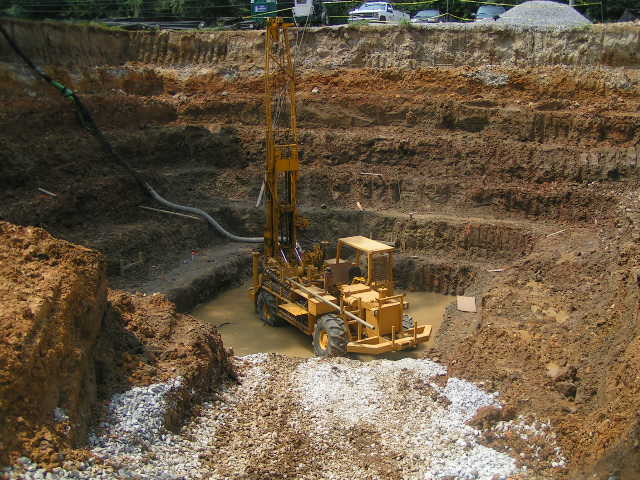Checking Out the Vital Role of Consulting Engineers in Geotechnical Projects: A Comprehensive Summary of Their Contributions and Duties
Consulting designers offer as crucial numbers within geotechnical jobs, charged with the complex obligations of assessing subsurface conditions and guaranteeing the structural integrity of constructions. Their proficiency not just shapes design criteria and regulatory conformity however also promotes important communication among numerous stakeholders, consequently enhancing task results. The intricacy of their duty is additional emphasized by the requirement for proactive threat monitoring techniques and ecological considerations. As we discover the multifaceted contributions of consulting designers, it comes to be obvious that their participation is crucial to navigating the obstacles intrinsic in geotechnical endeavors. What particular methods do these professionals employ to secure job success?
Summary of Geotechnical Design
Geotechnical design is a critical self-control within civil engineering that focuses on the behavior of earth materials and their interaction with frameworks. This area encompasses the study of soil, rock, groundwater, and the mechanics regulating their residential properties and actions. Geotechnical designers analyze the physical and chemical buildings of these products to establish their suitability for different building projects, guaranteeing that structures are established on secure and reliable ground.

Furthermore, geotechnical engineers have to take into consideration environmental variables, such as soil contamination and groundwater monitoring, to promote lasting development. Their know-how is necessary in optimizing the design and building and construction procedures, ultimately adding to the long life and safety of civil design projects.
Trick Obligations of Consulting Engineers

Additionally, they are liable for developing design specifications and specifications that follow regulatory standards and ideal techniques. This consists of evaluating site problems and figuring out proper building methods, which is essential for reducing risks related to ground instability.
Consulting engineers likewise function as intermediaries in between various stakeholders, consisting of clients, contractors, and regulatory bodies, promoting clear communication and collaboration throughout the job lifecycle. consulting civil engineering companies. Additionally, they provide expert support during building and construction, guaranteeing that geotechnical facets are adequately resolved which any kind of unexpected obstacles are managed properly. Inevitably, the diverse obligations of speaking with designers are basic to the honesty and success of geotechnical jobs, influencing both safety and sustainability in building techniques
Website Assessments and Investigations
A detailed website assessment is vital for recognizing the subsurface problems that affect geotechnical jobs. Consulting designers play a pivotal role in conducting these evaluations to make certain the safety and security and practicality of building activities. This process usually includes a collection of examinations, consisting of dirt tasting, borehole exploration, and geophysical studies, to collect important information on soil residential or commercial properties, groundwater levels, and the geological context of the site.
Engineers examine the acquired information to recognize the possible challenges posed by the subsurface conditions, such as dirt instability or high groundwater degrees, which can impact the layout and execution of the job. In addition, site assessments assist in examining the presence of pollutants, which is crucial for environmental conformity and making certain public safety and security.
Furthermore, speaking with engineers collaborate with multidisciplinary groups to incorporate findings from site investigations right into wider job purposes. Through strenuous documents and coverage, they provide essential understandings that inform stakeholders about the suitability of the website for suggested developments. Inevitably, the thoroughness of site analyses lays the foundation for effective planning and engineering services, mitigating risks associated with unexpected subsurface conditions.
Layout and Danger Management
After performing detailed website analyses, speaking with designers focus on the layout and danger administration facets of geotechnical projects. This stage is important as it guarantees that this website the engineered options are not just reliable however also risk-free and lasting (consulting civil engineering companies). Engineers use their proficiency to develop layouts that address the specific geotechnical problems identified throughout the website analyses, including dirt homes, groundwater actions, and prospective dangers
Danger management is essential to this procedure, as it involves recognizing, examining, and mitigating potential dangers connected with the project. Designers use different analytical techniques and modeling techniques to forecast the behavior of soil and rock under various loading conditions. By assessing unpredictabilities and prospective failing modes, they can recommend design adjustments that improve security and reduce threat.
In addition, consulting designers guarantee compliance with pertinent codes and standards, which are essential for decreasing liabilities. They additionally prepare backup strategies to address unforeseen challenges that might occur during building. Via thorough design and positive threat monitoring, speaking with engineers play a crucial role in ensuring the security, performance, and durability of geotechnical tasks, inevitably adding to the total my latest blog post success of the building undertaking.
Partnership With Job Stakeholders
Effective collaboration with project stakeholders is vital for the success of geotechnical tasks. Consulting engineers play a critical function in facilitating communication among various celebrations, consisting of clients, specialists, regulatory authorities, and environmental experts. This cooperation makes certain that all stakeholders have a clear understanding of job purposes, timelines, and possible risks.
Consulting engineers are in charge of incorporating stakeholder input into the layout and implementation of geotechnical services - consulting civil engineering companies. By proactively involving with stakeholders, they can identify worries early in the task lifecycle, making it possible for prompt changes and mitigating prospective conflicts. This positive technique not only cultivates trust but additionally improves project performance
Furthermore, getting in touch with designers need to browse the intricacies of regulative compliance, guaranteeing that all geotechnical techniques align with lawful and ecological criteria. Their competence around is critical in maintaining open lines of interaction with regulative bodies, thus promoting smoother approvals and allowing processes.
Verdict
